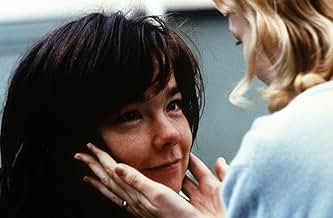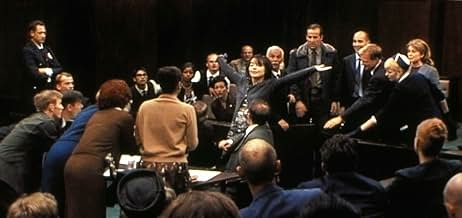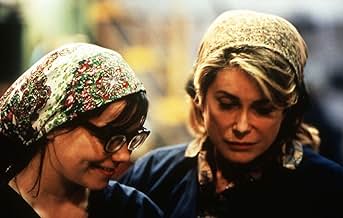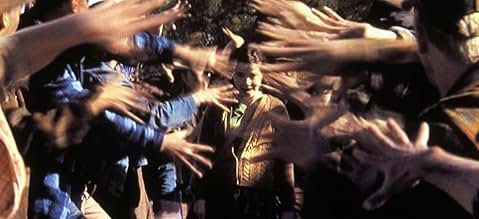An Eastern European US immigrant with a love for musicals has to cope with the gradual loss of her vision.An Eastern European US immigrant with a love for musicals has to cope with the gradual loss of her vision.An Eastern European US immigrant with a love for musicals has to cope with the gradual loss of her vision.
- Nominated for 1 Oscar
- 34 wins & 48 nominations total
Siobhan Fallon Hogan
- Brenda
- (as Siobhan Fallon)
- Director
- Writers
- All cast & crew
- Production, box office & more at IMDbPro
Storyline
Did you know
- TriviaIt took Lars von Trier a whole year to convince Björk to play the lead role.
- GoofsSelma's son's surname should be Jezek, not Jezková.
- Quotes
Lines on screen: They say it's the last song. They don't know us, you see. It's only the last song if we let it be.
- Alternate versionsThe film originally contained a song entitled "141 Steps"; however, after the Cannes premiere, director Lars von Trier decided to shorten it, and the song was subsequently reworked and retitled "107 Steps."
- SoundtracksOverture
Written by Björk
Arranged, Orchestrated & Conducted by Vincent Mendoza
Produced by Björk
Mixed by Mark Stent (as Mark "Spike" Stent)
Published by Universal Music
Featured review
Dancer in the Dark is the optimum anti-musical, juxtaposing the amateur aesthetic of the Dogme 95 movement against song numbers that are clearly color-corrected, shot with tripods, and otherwise more artificial than anything Dogme, centering around a sensational performance by Björk, as a Czechoslovakian immigrant who suffers for her altruism; a youthful innocence in the body of a tormented adult who enters the unrealistic world of movie musicals when she needs to flee. The music, naturally, is composed and sung almost entirely by her - and what music it is!
Though I have not yet seen all of them, Dancer in the Dark is very possibly the most genuinely good film from Danish provocateur Lars von Trier. While I admire or "appreciate" films like Antichrist and Melancholia for how they make me squirm and despair, it is easier to connect with the story and characters of Dancer in the Dark. Its unconventional choices in terms of style also make sense - mainly in regards to what I mentioned earlier about the overall "Dogme" look versus the production of the musical numbers - as opposed to those of Nymphomaniac, made at a point where Von Trier became too full of himself and did as he pleased.
My favorite creation of Von Trier's is his cult classic mini-series Riget (or The Kingdom for you non-Scandinavians), which is strange in ways more genuine than "I wish to be artsy and different". It is also the basis for Stephen King's decidedly less fascinating 2006 remake Kingdom Hospital, but these are all stories for another day.
Today's story is of Selma (Björk), a migrant in 1960's Washington State, who saves every penny she can of her income to pay for her son's operation, meant to rid him of the same illness that is presently turning her blind, a fact which she refuses to reveal. She lives on the property of an unhappy policeman (David Morse), is stalked by a local simpleton (Peter Stormare), and finds her only real friend within her colleague Kathy (Catherine Deneuve). Joel Grey also turns up as a fictionalized version of Oldrich Nový, one of Selma's idols, and what would a Von Trier film be without Udo Kier - the Murray to his Wes?
As her sight worsens, Selma pays more and more attention to the noises around her - the clatter-crash-thump of the machines she operates and the trains that pass - and discovers music, prompting her to envision song-and-dance sequences that, as mentioned, are shot, coordinated and colored quite differently than everything else (though still oddly framed at times, as with one number that was filmed on/around a moving train, on which several cameras were mounted and cut between in real-time, more or less). This is consistent with the Björk of the real world; finding all sorts of wonderful little details within the mundane.
When I recommend Von Trier's early work to friends, I often warn that his style takes some getting used to, and Dancer in the Dark will look unattractive to most. Another thing that possibly detracts would be Peter Stormare's singing voice during the Oscar-nominated "I've Seen It All", which was wisely replaced by that of Thom Yorke when Björk released her Selmasongs album. This was also the song that made Björk appear at the Oscars with that wonderful swan dress of hers, the most entertaining thing she's done since attempting to explain her TV.
All Peters aside, the music is hauntingly strange and flawlessly performed. After I finally watched the film, as I was advised to do by the Sardonicast crew in preparation for their next episode, it stayed on my mind for days to come and Selmasongs dominated my Spotify queue. Björk is often classified as avant-garde, experimental and electronic, hence it is surprising I haven't listened to the Icelandic treasure much yet.
Dancer in the Dark is outstandingly well-thought-out in just about every category; its song sequences make more sense than those of most musicals, the unconventional stylistic choices make more sense than those of many Von Trier films, and the songs are cleverly inspired by everyday noises. It's a devastating tale of a selfless person (hence its inclusion in the Golden Heart trilogy) and the world she retreats into until, perhaps, she learns it wasn't all hopeless.
Discussing Von Trier recently, I was told of how tiresome movies of misery and cruelty can be, especially when there is enough to go around in the real world. Dancer in the Dark is not cruel without purpose, arguably unlike the sulky Von Trier of today, and it does not end on an entirely pessimistic note. Even so, it might also make the case against the escapism you may find in a conventional, magical musical with a cheerful ending (not that every musical has this).
I like miserable movies, as they tend to be the most profound and challenging, but I like happy movies too, for surely obvious reasons. Dancer in the Dark, in a way, manages both.
Though I have not yet seen all of them, Dancer in the Dark is very possibly the most genuinely good film from Danish provocateur Lars von Trier. While I admire or "appreciate" films like Antichrist and Melancholia for how they make me squirm and despair, it is easier to connect with the story and characters of Dancer in the Dark. Its unconventional choices in terms of style also make sense - mainly in regards to what I mentioned earlier about the overall "Dogme" look versus the production of the musical numbers - as opposed to those of Nymphomaniac, made at a point where Von Trier became too full of himself and did as he pleased.
My favorite creation of Von Trier's is his cult classic mini-series Riget (or The Kingdom for you non-Scandinavians), which is strange in ways more genuine than "I wish to be artsy and different". It is also the basis for Stephen King's decidedly less fascinating 2006 remake Kingdom Hospital, but these are all stories for another day.
Today's story is of Selma (Björk), a migrant in 1960's Washington State, who saves every penny she can of her income to pay for her son's operation, meant to rid him of the same illness that is presently turning her blind, a fact which she refuses to reveal. She lives on the property of an unhappy policeman (David Morse), is stalked by a local simpleton (Peter Stormare), and finds her only real friend within her colleague Kathy (Catherine Deneuve). Joel Grey also turns up as a fictionalized version of Oldrich Nový, one of Selma's idols, and what would a Von Trier film be without Udo Kier - the Murray to his Wes?
As her sight worsens, Selma pays more and more attention to the noises around her - the clatter-crash-thump of the machines she operates and the trains that pass - and discovers music, prompting her to envision song-and-dance sequences that, as mentioned, are shot, coordinated and colored quite differently than everything else (though still oddly framed at times, as with one number that was filmed on/around a moving train, on which several cameras were mounted and cut between in real-time, more or less). This is consistent with the Björk of the real world; finding all sorts of wonderful little details within the mundane.
When I recommend Von Trier's early work to friends, I often warn that his style takes some getting used to, and Dancer in the Dark will look unattractive to most. Another thing that possibly detracts would be Peter Stormare's singing voice during the Oscar-nominated "I've Seen It All", which was wisely replaced by that of Thom Yorke when Björk released her Selmasongs album. This was also the song that made Björk appear at the Oscars with that wonderful swan dress of hers, the most entertaining thing she's done since attempting to explain her TV.
All Peters aside, the music is hauntingly strange and flawlessly performed. After I finally watched the film, as I was advised to do by the Sardonicast crew in preparation for their next episode, it stayed on my mind for days to come and Selmasongs dominated my Spotify queue. Björk is often classified as avant-garde, experimental and electronic, hence it is surprising I haven't listened to the Icelandic treasure much yet.
Dancer in the Dark is outstandingly well-thought-out in just about every category; its song sequences make more sense than those of most musicals, the unconventional stylistic choices make more sense than those of many Von Trier films, and the songs are cleverly inspired by everyday noises. It's a devastating tale of a selfless person (hence its inclusion in the Golden Heart trilogy) and the world she retreats into until, perhaps, she learns it wasn't all hopeless.
Discussing Von Trier recently, I was told of how tiresome movies of misery and cruelty can be, especially when there is enough to go around in the real world. Dancer in the Dark is not cruel without purpose, arguably unlike the sulky Von Trier of today, and it does not end on an entirely pessimistic note. Even so, it might also make the case against the escapism you may find in a conventional, magical musical with a cheerful ending (not that every musical has this).
I like miserable movies, as they tend to be the most profound and challenging, but I like happy movies too, for surely obvious reasons. Dancer in the Dark, in a way, manages both.
- TheVictoriousV
- Jun 16, 2020
- Permalink
- How long is Dancer in the Dark?Powered by Alexa
Details
- Release date
- Countries of origin
- Official sites
- Languages
- Also known as
- Bailarina en la oscuridad
- Filming locations
- Production companies
- See more company credits at IMDbPro
Box office
- Budget
- $12,800,000 (estimated)
- Gross US & Canada
- $4,184,036
- Opening weekend US & Canada
- $91,612
- Sep 24, 2000
- Gross worldwide
- $40,061,153
- Runtime2 hours 20 minutes
- Color
- Sound mix
- Aspect ratio
- 2.35 : 1
Contribute to this page
Suggest an edit or add missing content




















